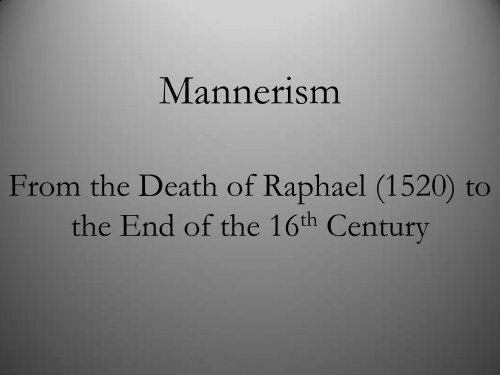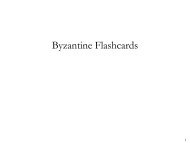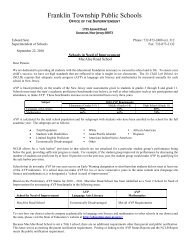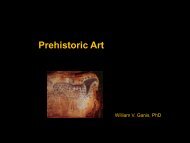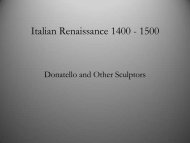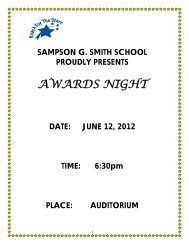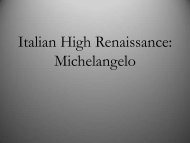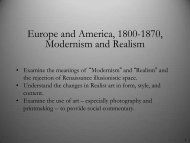Mannerism PDF
Mannerism PDF
Mannerism PDF
Create successful ePaper yourself
Turn your PDF publications into a flip-book with our unique Google optimized e-Paper software.
<strong>Mannerism</strong><br />
From the Death of Raphael (1520) to<br />
the End of the 16 th Century
<strong>Mannerism</strong><br />
• Understand <strong>Mannerism</strong> as an artificial style in contrast to the<br />
naturalism of the High Renaissance.<br />
• Examine <strong>Mannerism</strong> as interested in expressive forms of art<br />
rather than classical forms.<br />
• Explore the lives and works of key artists of the Mannerist<br />
style.<br />
• Recognize the artistic elements of Mannerist painting,<br />
sculpture, and architecture.<br />
2
Mannerist Painting<br />
• Recognize basic features of <strong>Mannerism</strong><br />
– Elongated figures<br />
– Figura Serpentinata<br />
– Less emphasis on balance, symmetry, and rational<br />
composition (values of High Renaissance)<br />
– Unusual lighting effects<br />
• Compare and contrast Mannerist painting with that of the<br />
High Renaissance<br />
3
Figure 22-43 PARMIGIANINO, Madonna with the Long<br />
Neck, from the Baiardi Chapel, Santa Maria dei Servi,<br />
Parma,Italy, 1534–1540. Oil on wood, 7’ 1” x 4’ 4”. Galleria<br />
degli Uffizi, Florence.<br />
4
Parmigianino,<br />
Self-Portrait in<br />
Convex Mirror
Figure 22-42 JACOPO DA PONTORMO,<br />
Entombment of Christ, Capponi Chapel, Santa<br />
Felicità, Florence, Italy, 1525–1528. Oil on wood,<br />
10’ 3” x 6’ 4”.<br />
8
Figure 22-47 TINTORETTO, Last Supper, 1594. Oil on canvas, 12’ x 18’ 8”. San Giorgio Maggiore, Venice.<br />
12
Figure 22-44 BRONZINO, Venus, Cupid,<br />
Folly, and Time, ca. 1546. Oil on wood, 5’ 1” x<br />
4’ 8 1/4”. National Gallery, London.<br />
14
Mannerist Portraiture<br />
• Examine the portrait as an expressive form of art.<br />
• Explore the lives and works of key artists of the Mannerist<br />
style.<br />
18
Figure 22-45 BRONZINO, Portrait of a<br />
Young Man, ca. 1530–1545. Oil on wood, 3’ 1<br />
1/2” x 2’ 5 1/2”. Metropolitan Museum of<br />
Art, New York (H. O. Havemeyer Collection,<br />
bequest of Mrs. H. O. Havemeyer, 1929).<br />
19
Figure 22-46 SOFONISBA ANGUISSOLA, Portrait of the Artist’s Sisters and Brother, ca. 1555. Oil on panel, 2’ 5 1/4” x 3’<br />
1 1/2”. Methuen Collection, Corsham Court, Wiltshire.<br />
20
Figure 22-48 PAOLO VERONESE, Christ in the House of Levi, from the refectory of Santi Giovanni e Paolo, Venice,<br />
Italy, 1573. Oil on canvas, 18’ 3” x 42’. Galleria dell’Accademia, Venice.<br />
21
Figure 22-49 PAOLO VERONESE, Triumph of<br />
Venice, ca. 1585. Oil on canvas, 29’ 8” x 19’. Ceiling<br />
of the Hall of the Grand Council, Doge’s Palace,<br />
Venice.<br />
22
Figure 22-50 CORREGGIO, Assumption of the<br />
Virgin, 1526–1530. Fresco, 35’ 10” x 37’ 11”. Parma<br />
Cathedral, Parma.<br />
23
1. The image on the left uses the medium of<br />
A. egg tempera<br />
B. fresco buon<br />
C. encaustic<br />
D. oil on panel
2. The image on the left is part of a cycle that is in the<br />
A. Arena Chapel in Padua<br />
B. Palazzo Pubblico in Siena<br />
C. Palazzo Ducale in Mantua<br />
D. Piazza San Marco in Venice
3. The image on the left was created in the<br />
A. 1200s<br />
B. 1300s<br />
C. 1400s<br />
D. 1500s
4. Which of the following was NOT a contemporary of<br />
the artist who produced the work on the left?<br />
A. Masaccio<br />
B. Duccio<br />
C. Simone Martini<br />
D. Cimabue
5. The style of the image on the right is best described as<br />
A. Renaissance<br />
B. Mannerist<br />
C. International Style<br />
D. Proto-Renaissance
6. A distinguishing stylistic element of the image on the<br />
right is its<br />
A. elongated figures<br />
B. clarity of composition<br />
C. uniform light source<br />
D. sensuous colors
7. Which of the following artists was NOT associated<br />
with the style of the work on the right?<br />
A. Parmigianino<br />
B. Bronzino<br />
C. Pontormo<br />
D. Andrea del Castagno
8. Both images are similar in their<br />
A. composition<br />
B. religious narrative<br />
C. modulation of light<br />
D. medium
Mannerist Sculpture<br />
• Examine the expressive forms of sculpture.<br />
• Recognize the artistic elements of Mannerist sculpture.<br />
33
Figure 22-51 BENVENUTO CELLINI, Saltcellar of Francis I, 1540-1543. Gold, enamel, and ebony, 10 ¼” X<br />
1’ 1’ 1/8”. Kunsthisotrisches Museum, Vienna.<br />
34
Pepper Detail
Sea god<br />
detail
Sea horse detail
Nude figures details
Benvenuto Cellini, The Genius of Fountainbleau
Cellini: Perseus
Figure 22-52 GIOVANNI DA BOLOGNA, Abduction of the<br />
Sabine Women, Loggia dei Lanzi, Piazza della Signoria, Florence,<br />
Italy, 1579–1583. Marble, 13’ 5 1/2” high.<br />
42
Laocoon
Bologna:<br />
“Venus”
Michelangelo: The<br />
Later Years
First, a review:
MEDICI CHAPEL -<br />
TOMB OF<br />
GIULIANO
Night detail
Day detail
Tomb of<br />
Lorenzo
Lorenzo<br />
detail
Twilight detail
Dawn detail
Medici<br />
Madonna
Florentine<br />
Pieta
JOSEPH OF ARIMATHAEA, DETAIL
RONDANINI<br />
PIETÀ
Mannerist Architecture<br />
• Spot idiosyncrasies of Mannerist architecture<br />
• Compare and contrast High Renaissance architecture and<br />
Mannerist architecture<br />
77
Figure 22-53 GIULIO ROMANO, interior courtyard facade of the Palazzo del Tè, Mantua, Italy, 1525–1535.<br />
78
Figure 22-54 MICHAELANGELO BUONARROTI, Piazza del Campidoglio, Capitoline Hill, Rome Italy,<br />
1536 - 46.
Figure 22-54 MICHAELANGELO BUONARROTI, Piazza del Campidoglio, Capitoline Hill, Rome Italy,<br />
1536 - 46.
Figure 22-54 MICHAELANGELO BUONARROTI, Piazza del Campidoglio, Capitoline Hill, Rome Italy,<br />
1536 - 46.
Figure 22-55<br />
GIACOMO DELLA<br />
PORTA, facade of Il<br />
Gesù, Rome, Italy, ca.<br />
1575–1584.<br />
83
Alberti<br />
Figure 22-55<br />
GIACOMO DELLA<br />
PORTA, facade of Il<br />
Gesù, Rome, Italy, ca.<br />
1575–1584.<br />
84
Figure 22-56 GIACOMO<br />
DA VIGNOLA, plan of Il<br />
Gesù, Rome, Italy, 1568. (1)<br />
dome, (2) nave, (3) chapel.<br />
85
Discussion Questions<br />
<br />
<br />
<br />
Why do works of art from the High Renaissance continue<br />
to be understood as the most famous art in the western<br />
world?<br />
What are the elements of Mannerist art and sculpture that<br />
are different from the art of the High Renaissance?<br />
What plans and theories of the architect Palladio continue<br />
to be seen in architecture to this day?<br />
86


